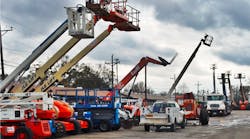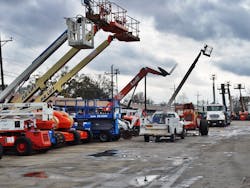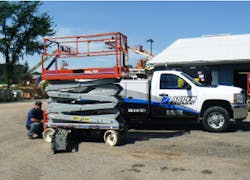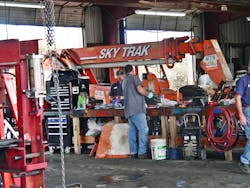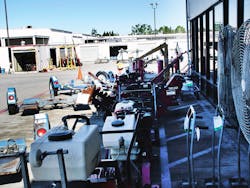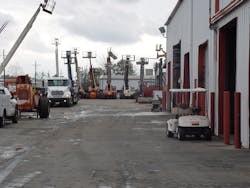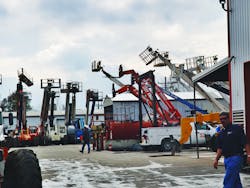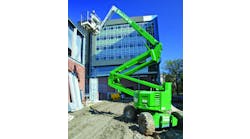Despite concerns about 2012 being an election year, and economic issues such as high unemployment, the slowdown in Europe and the burgeoning costs of equipment, 2012 turned out to be a banner year for much of the rental industry. And, to the relief of many, despite widespread misinterpretations of the Mayan calendar, the world didn't come to an end in late December.
Then, 10 days later, we passed from the end of the world to the fiscal cliff. Last-minute legislation was passed, and we haven't really leapt yet, although the degree of the precipice still requires action and more negotiation. Important issues regarding taxes, spending cuts, the debt ceiling and budgets are still delicate balances that can create economic tidal waves if not handled carefully. But for the most part, it appears to be back to business, with construction markets in varying phases of recovery.
While many rental people say they still have a long upward climb to get back to the levels of 2007 or whenever their peak year was, rental revenues — according to most of the people interviewed for this article by RER — increased during 2012 from 5 to as much as 25 percent compared to the previous year.
Some of the increases must be tempered by the perspective that it is still a time of recovery from a powerful recession, somewhat akin to climbing out of a deep ditch. As California manufacturers' rep Rick Beals, who makes his living selling to rental centers and for whom the bottom of the recession was in 2010, says: “The total drop from top to bottom was probably about 60 percent. 2011 was about 10-percent up from the bottom in 2010. 2012 was another 10 percent from 2011. So we're still down quite a bit, but I like the upward trend.”
While for many areas of the country the drop to the bottom wasn't as severe as in California, nonetheless, many suffered precipitous drops and still are climbing out.
For Rick Dahl of Metrolift, Sugar Grove, Ill., the ditch looks small from the baskets of the aerial work platforms his company rents. “Our revenue is growing at a rate of 8 percent in 2012 after a 22-percent effort in 2011,” he says. “We are very close to being back to our record 2008 levels. In 2012 we had our best rental month ever.”
As 2013 begins, rental people have concerns about the economy, just as people in nearly all fields. In many areas of the United States, residential construction is beginning a comeback, the energy markets are solid, and non-residential is making tentative steps towards recovery. The fear of dropping off the fiscal cliff was prevalent as research for this article was in process, with business people in all sectors greatly concerned about the potential impact of tax law changes. While the fiscal cliff seems to have been averted, there are still major issues that have to be dealt with.
Nonetheless, the outlook for 2013 is, for the most part, far more positive than it has been for years. Most rental companies are expecting an increase in 2013, with expectations ranging from modest to double-digit.
“We are very optimistic about 2013 and expect similar growth to what we achieved in 2012,” says Benno Jurgemeyer, CEO of Phoenix-based Sunstate Equipment. “Our optimism for the most part is based on the opportunities we are seeing in the market place, in both the construction and non-construction business segments. We are seeing a lot of new construction breaking ground and more of these projects are coming from the private sector. We are also seeing evidence that the residential market is turning the corner, a good sign that the general economy is making progress. We have been outpacing the economic forecasts for two years, which is consistent with the theory that rental is increasing its share.”
Part of Jurgemeyer's optimism, in a view expressed by others as well, is that there appears to be a greater variety of projects on the horizon, including solar plants, stadiums, auto malls, distribution centers, hospitals, apartments, healthcare, retail and more.
“Currently non-residential construction has improved significantly, including private investment,” says Bob Kendall, Star Rentals. “Customers are generally more upbeat. Residential is improving as well, which typically precedes commercial expansion. The Pacific Northwest is more of an ‘intellectual economy’ with strong ties to aerospace, biomedical, and high-tech. Our ‘gut feel’ is that we will see those industries expand in future years.”
Graham Hood of Neff Rental agrees with the basic scenario, although Neff's markets range from the Southeast to the Southwest. “Many of the key indicators that we look at are pointing to continued modest growth in most of our markets,” he says. “Dodge is predicting 6-percent growth in overall construction, the ABI has been trending positively above 50 for several months and Global Insight is predicting continued growth performance for the rental industry, aided by the accelerated shift from equipment ownership to rental. These factors along with the ongoing strength of the energy sector and a slowly improving general economy indicate that we should see continued improvement in our business in 2013.”
Dale Leppo of Leppo Rents, based in Tallmadge, Ohio, expects about a 10-percent growth in 2013. “Oil and gas are just beginning to take off in Ohio, residential housing has some life,” he says. “Nothing like 2005-6, but better than the last few years. Many of our customers are making money and buying, fixing and renting equipment.”
Customer Shift
The more positive outlook rental companies seem to share going into 2013 is based on reports from a variety of sources but none more important than their customers, who, while mixed, are generally more optimistic than in recent years. Even some of the issues that concern customers could be advantageous for rental.
“Customers anticipate 2013 to be similar to the last six months, not bad but not great,” says Bill Gex, CEO of Anderson Equipment Co., Bridgeville, Pa. “There are some positive factors that will have a favorable impact on business — highway/infrastructure spending and ongoing government spending combined with the ongoing recovery of the housing sector — but there are also a number of negative issues such as a likely increase in taxes, increasing regulations and higher costs of doing business. The different signals being processed by business owners are creating an ongoing bias to rent equipment vs. owning.”
Sunstate's Jurgemeyer agrees that issues that might concern the rental industry will also concern the customer in a way that can benefit rental. “The increasing cost of equipment will be a longer-term challenge for rental industry economics,” he says. “Longer because it will take years to increase the average cost of the fleet. At the same time it will also make it more challenging for customers to justify the investment in the higher cost machines; which should translate to greater reliance on the rental option.”
Volvo Rents' Barry Natwick says that another factor that favors rental is that customers, just like rental companies, survived the downturn by learning to work more efficiently. Hence, those that survived are stronger for it.
“Our customers continue to stretch themselves to be more efficient with the reduced amount of work and capital available,” Natwick says. “[Also], more customers are doing work in larger geographical areas making rental more prudent.”
“Some customers are already booked for most of 2013,” adds Leppo. “Some are struggling. Most are unhappy about what is going on in Washington, D.C., and that gives them reasons to be cautious. It is a mixed bag, but the overall mood is more positive than the last few years.”
“A lot are optimistic and they're purchasing things,” says John Grill of Aaction Rents, based in Windsor, Calif. “Some of the reasons the rental business is growing too is that people are hesitant, cautiously optimistic. Some people had their credit destroyed during 2007-2010, and maybe stuff is so expensive that they've chosen rental as a good option.”
Of course no rental company has more customers than United Rentals and therefore what its customers expect has to be considered in any analysis of the market.
Geography, Energy and Infrastructure
If there's a rental industry improvement in 2013, will it be widespread? Geography certainly plays a role. Not all regions are recovering at the same rate, with a distinct advantage felt in “energy states” where proximity to energy-exploration, oil extraction or refineries, wind farms and other industries related to energy are finding business to be more robust than other areas.
“Most of our customers are very optimistic, we think this will be a three- to five-year run,” says Fred Leach of Odessa, Texas-based Cisco Equipment, a company that is benefiting from pipeline construction, and industrial markets related to oil and natural gas. “It appears at this time the domestic inland oil market will remain strong for some time.”
“The Washington D.C. metro area is bustling with activity,” says Joel Theros of Theros Equipment. “There are lots of commercial, residential, and government projects either in progress or getting ready to start happening here. New home construction has picked up quite a bit in northern Virginia.” “Now that the election is over, I think the new tax laws will stun the economy for the first quarter in the Midwest but we still see a strong upswing in our petro-based companies, steel industry, and utilities,” says Al Kropp of Kropp Equipment, Schererville, Ill.
“There is still pent-up demand in the utility/water and sewer segment that needs to be addressed,” says Volvo Rents' Natwick. “The energy sector will continue its growth with large projects and upgrades to aged facilities.”
Bill Thompson, whose Thompson Pump rents pumps to a variety of industries, says, “Mining for precious metals, minerals and rare earth elements continues to be relatively strong. Electric generating plants are being upgraded, mostly by private investment, to natural gas. The coal-fired plants are being upgraded to higher efficiencies and with better pollution-control equipment. Oil and gas pipelines, such as the Keystone XL pipeline, are on the table. The passage of the recent highway bill, while not great, does give us reason for optimism. Many housing, commercial and institutional development projects are still in limbo but they're still viable. The seaports, especially on the East Coast, are being expanded, widened and deepened for the larger ships made possible by the widening of the Panama Canal.”
Work related to recovery from Hurricane Sandy will be a big market on the East Coast. “In addition to storm-related work, natural gas drilling in Pennsylvania and some major bridge projects such the Tappan Zee Bridge in New York,” present opportunities according to Pat DeVitto of Cardinal Sales, Brooklyn, N.Y.
“Oil and gas exploration and all of the infrastructure that surrounds it [look strong],” says Leppo. “The state of Ohio estimates this will add $6 billion a year to the state gross product. Some housing construction will likely happen. Hospitals are expanding.”
Brian LaLonde of LaLonde Equipment, Signal Hill, Calif., sums up the opportunities he sees in one word: infrastructure. “Bridges, rail, grade separations, freeway improvements and port upgrades,” he says.
“Housing is finally starting to move again and this underpins a lot of our customers' demand and will lead to non-residential construction improvements in 2014 and beyond,” says Ron DeFeo, chairman and CEO of Terex Corp. “Furthermore the U.S. population continues to grow, so this is a positive. We see some positive signs for U.S. manufacturing. This is another important customer category.”
Bumping up Inventory
With greater possibilities on the horizon, it would stand to reason that rental companies will be bumping up their inventory in 2013. In some cases yes; others are more likely to take the cautious route, which might mean taking chances that equipment will be easy to obtain when they need it, a risky assumption in these “made-to-order” times.
Most rental companies do plan to spend in 2013, ranging from relatively minor increases to the $1.5 billion that United Rentals expects to spend.
But not all suppliers to the rental industry are sensing a dramatic boost in buying. “Most rental companies have been very cautious,” says Ron Johnson of FTG Equipment, a Carney's Point, N.J.-based equipment distributor. “They will continue to be careful in 2013. On the other hand, there is some pent-up demand out there that will be exercised in 2013. One of the bigger challenges will be the greater expense in acquiring Tier IV products starting on January 1. Some manufacturers are talking about 30- to 40-percent increases in equipment prices. Because of the greater cost, and a possible scarcity of Tier 4 final engines, inventory levels may also decline.”
While fiscal caution and higher price tags are likely to play a role in inventory expansion for rental companies in 2013, improved business will likely lead to manufacturers finding a fairly solid market for machines going to rental fleets.
Strategies for Growth
A year or two ago, few rental companies were considering growth plans, although some companies such as Phoenix-based A to Z Rentals & Sales took advantage of the old business maxim that says a downturn is the best time to expand.
“During the downturn we took advantage of opportunities, opening a new branch in the West Valley (Avondale) and purchased property next to our North Phoenix store for future expansion of that location,” says Doug Dickerson, sales manager. “We also expanded our Gilbert store. We will add to our sales staff this year, both inside and outside. We will also focus more effort on large commercial landscape contractors and construction contractors that fit within our niche offerings. We plan to incorporate more equipment-related You Tube videos into our website and are considering the use of Facebook with our party/event business.”
Adding to sales staff was cited by many of the rental companies interviewed for this story. While a few say they are looking at possible branch expansion, further penetration of existing markets seems to be the more popular option for many companies at the moment. Even Volvo Rents, which has been acquiring companies and expanding into new markets at a breakneck pace, says it expects to focus on letting customer growth pull it into expanding markets in 2013 “rather than expand purely for location growth,” says Natwick.
“We plan a new marketing program for 2013,” says John Hofmeyer, rental manager for Elmhurst, Ill.-based Patten Industries. “Remodeling branches that we didn't do in 2012. [Working on] better market penetration in outlying areas of the territory.”
“We are most likely going to continue with diversifying our customer base to be less dependent upon nonresidential construction,” says Star Rental's Kendall. “We have made great strides over the past three to four years expanding industrial, governmental, and institutional segments. We are also committed to introducing new POS software in late 2013 or early 2014, which we see as a huge step towards growing our social media opportunities as well.”
While the rental industry will never be known for early adoption of social media, many rental companies are working on stepping up their efforts on Facebook, LinkedIn, Twitter and other social media outlets.
Sleepless in Seattle?
While the rental industry appears to be in a strong cycle, they are not without some issues of concern. While Star Rentals' Kendall claims to be sleeping fine in Seattle, not terribly worried about international economic issues and many a rental person optimistically states that concerns over the economy are, in fact, good for rental because times of uncertainty discourage large outlays of capital, there are still issues that cannot be ignored even if they cannot be controlled.
To start with, there's the fiscal cliff that still loomed large as we researched this article.
“The consequences of falling off the cliff could be caused more by the perception than the actuality,” says Mike Grant, portable products and rental market manager for pump manufacturer Tsurumi. “The stock market [could] drop, personal portfolios [could] devaluate, individuals and businesses [could] hold off spending money. The economy [could] certainly suffer, but we will not crawl into a hole and hide. While our expectations for 2013 are flat overall we expect that certain regions will thrive.”
“The fiscal cliff and Illinois being broke and seeing companies move out of the state,” are issues that concern Patten's Hofmeyer. “Cost of equipment not in proportion to rental rate increases.”
Quite a few are expressing concern about the rising cost of equipment, especially in proportion to rental rates.
“When a dump truck goes from say, $45,000 to $65,000, a rental operator really has to look at what kind of return he or she can realize,” says FTG's Johnson. “And no rental company wants to raise rates by 30 percent, because rental customers are probably not going to understand all of the reasons for the increases. I am not sure that the EPA didn't overestimate the ability of engine manufacturers to respond in a way that would not cripple them, and their customers. Some engines will almost double in price in order to meet Tier 4 final emission standards.”
“Our rental rates are not increasing as quickly as the cost of new equipment so we must outperform our competition in many other areas such as on-time delivery, correct billing and service response time,” adds Metrolift's Dahl.
“We have to raise our rental rates, but we need leadership in this area from big equipment dealerships,” says Mike Rooney, rental manager of Aurora, Colo.-based Worldwide Rental Services. “It's pretty hard to compete when I'm renting a five-year-old scraper and the dealership is renting a brand-new one with plastic still covering the seat and I'm asking for a higher rate.”
For those concerned about the effects of EPA regulations, they can at least be glad they don't work in California where the regulations are even more stringent. “In California, the [California Air Resources Board] regulations are really starting to have an effect on fleet planning, cash flow and the balance sheet,” says John Wooten of Fairfield, Calif.-based All Star Rents. “While we have been dealing with it for several years now, the bigger ticket items are now starting to get affected like big rig trucks. Off-road diesel and smaller diesel trucks are right around the corner.”
“Now that the uncertainty of the election is behind us, we'll be watching the fiscal situation and any revitalization efforts very closely,” sums up United Rentals' Kneeland. “We expect that North America will be dealing with the impact of fluctuations in the global economy for some time. The best way to mitigate that is for American businesses to begin investing in growth again.
“Recently, the U.S. Department of Labor data has shown small increases in the number of construction-related jobs. That's encouraging, but the rebound is still relatively minor compared to the depth of the construction job loss during the worst of the downturn. In many ways, the end markets we serve are a litmus test for economic health in the U.S. and Canada. An improvement in the macro environment manifests itself in better business conditions for our customers, and that seems to be taking place.”
Although there is plenty to be concerned about, and rental industry participants have to keep a watchful eye towards difficulties that might arise down the road, there is more reason for rental people to be optimistic going into 2013 than there has been in years.
